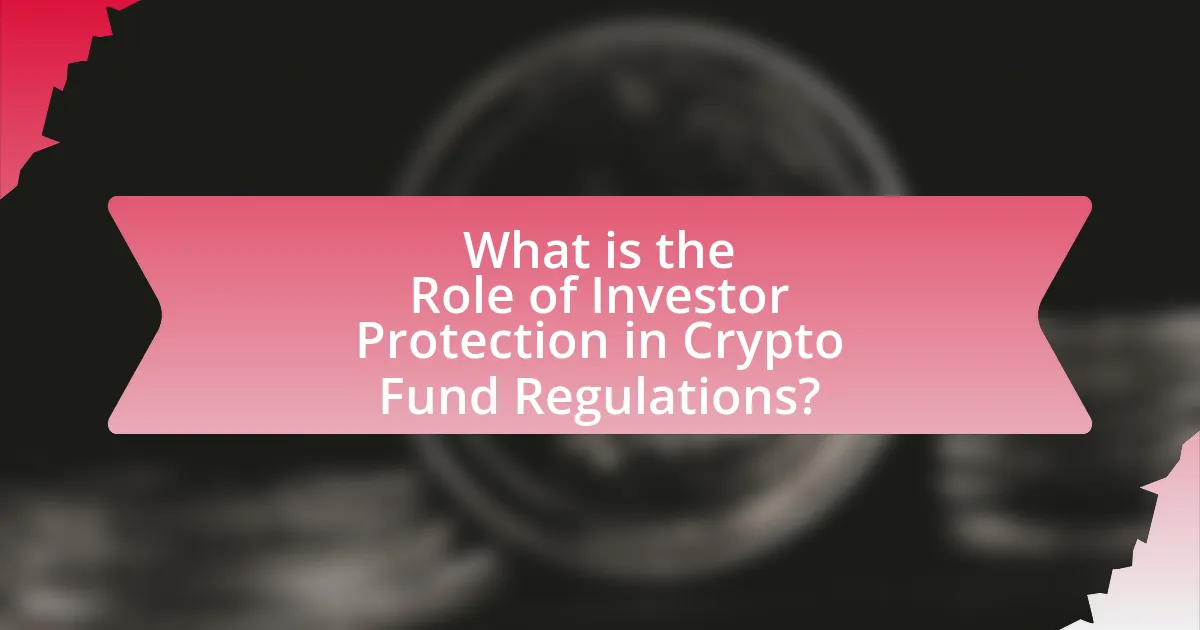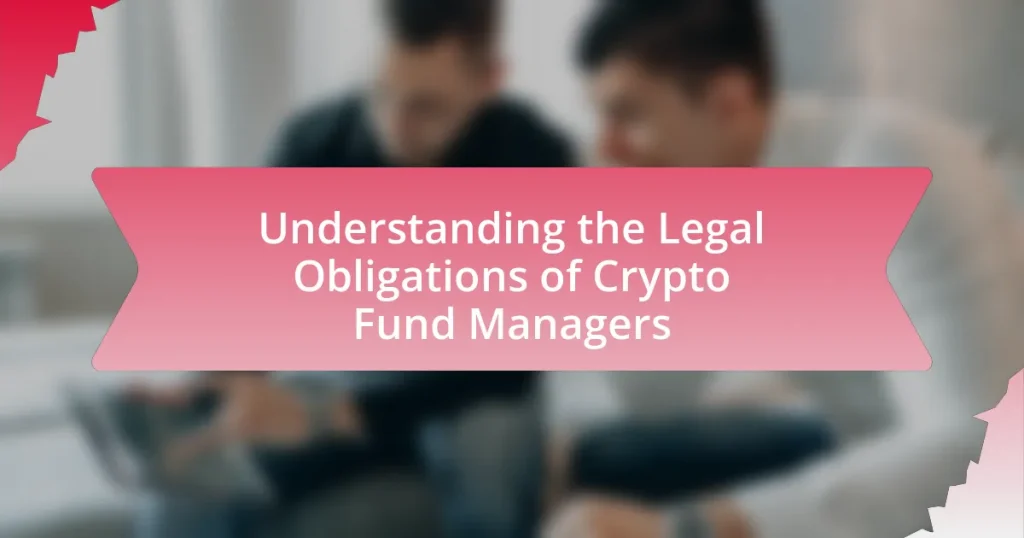Investor protection plays a critical role in the regulation of crypto funds, aiming to shield individuals from fraud, market manipulation, and the volatility inherent in cryptocurrencies. Regulatory frameworks, such as those enforced by the U.S. Securities and Exchange Commission (SEC), mandate transparency and risk disclosure, fostering informed decision-making among investors. The article explores the various risks faced by investors in the crypto fund market, including market volatility and cybersecurity threats, and discusses how investor protection measures can mitigate these risks through compliance requirements and regulatory oversight. Additionally, it examines the evolving regulatory landscape, the impact of technological advancements, and best practices for investors to ensure their protection in this dynamic environment.

What is the Role of Investor Protection in Crypto Fund Regulations?
Investor protection in crypto fund regulations serves to safeguard individuals from fraud, market manipulation, and the inherent volatility of cryptocurrencies. Regulatory frameworks aim to establish transparency, requiring crypto funds to disclose risks, fees, and investment strategies, thereby enabling informed decision-making by investors. For instance, the U.S. Securities and Exchange Commission (SEC) enforces rules that mandate registration and compliance for investment products, which helps mitigate risks associated with unregulated crypto assets. This regulatory oversight is crucial, as it fosters trust in the market and encourages broader participation by ensuring that investors have access to essential information and recourse in cases of misconduct.
Why is investor protection crucial in the context of crypto funds?
Investor protection is crucial in the context of crypto funds because it safeguards investors from fraud, market manipulation, and the inherent volatility of cryptocurrencies. The rapid growth of the crypto market has led to numerous scams and unregulated practices, making it essential for regulatory frameworks to establish clear guidelines that ensure transparency and accountability. For instance, the U.S. Securities and Exchange Commission (SEC) has emphasized the need for investor protection to maintain market integrity and foster investor confidence, as evidenced by its enforcement actions against fraudulent crypto schemes. By implementing robust investor protection measures, regulators can help mitigate risks and promote a safer investment environment in the evolving landscape of crypto funds.
What risks do investors face in the crypto fund market?
Investors in the crypto fund market face several significant risks, including market volatility, regulatory uncertainty, and cybersecurity threats. Market volatility is a primary concern, as cryptocurrencies can experience extreme price fluctuations; for instance, Bitcoin’s price dropped from nearly $65,000 in April 2021 to around $30,000 by July 2021, illustrating the unpredictable nature of these assets. Regulatory uncertainty poses another risk, as governments worldwide are still developing frameworks for cryptocurrency, which can lead to sudden changes in legality or operational requirements. Additionally, cybersecurity threats are prevalent, with numerous high-profile hacks resulting in substantial losses; for example, the 2016 hack of the DAO resulted in the loss of $60 million worth of Ether. These factors collectively contribute to a high-risk environment for investors in the crypto fund market.
How does investor protection mitigate these risks?
Investor protection mitigates risks in crypto fund regulations by establishing legal frameworks that ensure transparency, accountability, and fair treatment of investors. These frameworks often include requirements for disclosure of information, which helps investors make informed decisions and reduces the likelihood of fraud. For instance, regulatory bodies like the U.S. Securities and Exchange Commission enforce rules that mandate crypto funds to provide clear information about their operations, risks, and fees. This transparency helps to build trust and reduces the risk of financial loss due to misinformation or deceptive practices. Additionally, investor protection mechanisms, such as insurance schemes and dispute resolution processes, provide recourse for investors in case of fund mismanagement or insolvency, further safeguarding their investments.
What are the key components of investor protection in crypto fund regulations?
The key components of investor protection in crypto fund regulations include transparency, risk disclosure, and regulatory oversight. Transparency ensures that investors have access to clear and accurate information about the fund’s operations, investment strategies, and performance metrics. Risk disclosure mandates that funds inform investors about potential risks associated with cryptocurrency investments, including market volatility and regulatory changes. Regulatory oversight involves the establishment of frameworks by government bodies to monitor and enforce compliance with laws designed to protect investors, such as anti-fraud measures and licensing requirements for fund managers. These components collectively aim to safeguard investor interests and promote confidence in the crypto market.
What regulatory frameworks exist to protect investors in crypto funds?
Regulatory frameworks that exist to protect investors in crypto funds include the Securities and Exchange Commission (SEC) regulations in the United States, which classify certain cryptocurrencies as securities, thereby subjecting them to federal securities laws. These laws require registration of investment products and provide guidelines for disclosures, ensuring transparency and protecting investors from fraud. Additionally, the Financial Action Task Force (FATF) has established guidelines for anti-money laundering (AML) and combating the financing of terrorism (CFT) that apply to crypto funds, promoting accountability and security in transactions. In the European Union, the Markets in Crypto-Assets (MiCA) regulation aims to create a comprehensive regulatory framework for crypto assets, enhancing investor protection through licensing requirements and consumer safeguards. These frameworks collectively aim to mitigate risks associated with crypto investments and enhance investor confidence.
How do these frameworks vary across different jurisdictions?
Investor protection frameworks in crypto fund regulations vary significantly across different jurisdictions due to differing legal interpretations, regulatory approaches, and market maturity. For instance, the United States employs a combination of federal and state regulations, primarily through the Securities and Exchange Commission (SEC), which classifies many cryptocurrencies as securities, thus subjecting them to stringent investor protection laws. In contrast, the European Union is developing a unified regulatory framework under the Markets in Crypto-Assets (MiCA) regulation, which aims to provide a comprehensive approach to investor protection while fostering innovation. Additionally, jurisdictions like Switzerland have adopted a more permissive stance, allowing for greater flexibility in crypto fund operations while still ensuring investor safeguards through the Swiss Financial Market Supervisory Authority (FINMA). These variations reflect the local economic contexts, regulatory philosophies, and levels of investor sophistication, influencing how effectively investor protection is implemented in the crypto space.
What challenges do regulators face in ensuring investor protection in crypto funds?
Regulators face significant challenges in ensuring investor protection in crypto funds due to the decentralized nature of cryptocurrencies, which complicates oversight and enforcement. The lack of a centralized authority makes it difficult for regulators to track transactions and identify fraudulent activities, as evidenced by the rise in scams and hacks within the crypto space, with losses exceeding $14 billion in 2021 alone. Additionally, the rapid evolution of technology and financial products in the crypto market outpaces regulatory frameworks, leading to gaps in consumer protection laws. Furthermore, the global nature of cryptocurrency markets creates jurisdictional issues, as different countries have varying regulations, making it challenging to implement consistent protective measures for investors.
How do technological advancements complicate regulatory efforts?
Technological advancements complicate regulatory efforts by introducing rapid changes in financial technologies that outpace existing regulatory frameworks. For instance, innovations such as blockchain and decentralized finance (DeFi) create new financial products and services that often operate outside traditional regulatory oversight, making it difficult for regulators to enforce compliance. Additionally, the global nature of technology allows crypto assets to be traded across borders, complicating jurisdictional authority and enforcement. According to a report by the Financial Stability Board, the decentralized nature of cryptocurrencies poses challenges for regulators in monitoring and mitigating systemic risks, as these assets can be transferred anonymously and instantaneously, bypassing established financial systems.
What are the limitations of current regulatory approaches?
Current regulatory approaches face significant limitations, including a lack of uniformity across jurisdictions, which leads to regulatory arbitrage. This inconsistency allows crypto funds to operate in less regulated environments, undermining investor protection. Additionally, many regulations are outdated and do not adequately address the unique characteristics of cryptocurrencies, such as their volatility and the potential for fraud. For instance, the Financial Action Task Force (FATF) has highlighted that existing anti-money laundering frameworks often fail to capture the complexities of crypto transactions. Furthermore, regulatory bodies often lack the technical expertise necessary to effectively oversee rapidly evolving technologies in the crypto space, resulting in ineffective enforcement and oversight.

How do investor protection measures impact the crypto fund industry?
Investor protection measures significantly enhance the credibility and stability of the crypto fund industry. These measures, such as regulatory frameworks and compliance requirements, help to safeguard investors’ assets and ensure transparency in fund operations. For instance, jurisdictions that implement strict Know Your Customer (KYC) and Anti-Money Laundering (AML) regulations create a safer environment, which can lead to increased investor confidence and participation. According to a report by the Financial Action Task Force (FATF), countries that enforce robust investor protection protocols see a higher level of institutional investment in cryptocurrencies, indicating that such measures are crucial for the industry’s growth and legitimacy.
What benefits do strong investor protection measures provide to the crypto fund market?
Strong investor protection measures enhance the crypto fund market by fostering trust and stability among investors. These measures mitigate risks associated with fraud and mismanagement, which are prevalent in the volatile crypto landscape. For instance, regulatory frameworks that enforce transparency and accountability can lead to increased investor confidence, resulting in higher capital inflows. According to a report by the Financial Stability Board, jurisdictions with robust investor protections have seen a 30% increase in institutional investment in crypto assets, demonstrating the direct correlation between investor safeguards and market growth.
How do these measures enhance investor confidence?
Investor protection measures enhance investor confidence by providing a structured framework that ensures transparency, accountability, and security in crypto fund operations. These measures, such as regulatory compliance, mandatory disclosures, and robust risk management protocols, create an environment where investors feel their interests are safeguarded. For instance, regulatory bodies like the SEC require crypto funds to adhere to strict reporting standards, which helps to mitigate fraud and mismanagement risks. This transparency allows investors to make informed decisions based on reliable information, thereby increasing their trust in the market. Additionally, the establishment of clear legal recourse in cases of disputes further reassures investors that their rights are protected, fostering a more stable investment climate.
What effect do they have on market stability?
Investor protection measures in crypto fund regulations enhance market stability by reducing fraud and increasing investor confidence. When regulations are in place, they help to mitigate risks associated with market manipulation and ensure that investors have access to accurate information. For instance, the implementation of Know Your Customer (KYC) and Anti-Money Laundering (AML) regulations has been shown to decrease the incidence of fraudulent activities in financial markets, thereby fostering a more stable trading environment. Additionally, studies indicate that markets with robust investor protections tend to experience lower volatility, as investors are more likely to participate when they feel secure in their investments.
How do investor protection regulations influence fund managers and their operations?
Investor protection regulations significantly influence fund managers and their operations by imposing compliance requirements that enhance transparency and accountability. These regulations mandate fund managers to disclose risks, fees, and investment strategies, which fosters trust among investors and mitigates potential conflicts of interest. For instance, the Securities and Exchange Commission (SEC) in the United States enforces rules that require registered investment advisers to act in the best interest of their clients, thereby shaping the operational practices of fund managers to prioritize investor welfare. Additionally, adherence to these regulations often necessitates the implementation of robust risk management frameworks, which can lead to more prudent investment decisions and ultimately protect investor capital.
What compliance requirements must fund managers adhere to?
Fund managers must adhere to compliance requirements that include registration with regulatory bodies, adherence to anti-money laundering (AML) and know your customer (KYC) regulations, and maintaining transparency in reporting and disclosures. These requirements are enforced by entities such as the Securities and Exchange Commission (SEC) in the United States and similar organizations globally, which mandate that fund managers provide accurate information regarding their investment strategies, risks, and fees to protect investors. Compliance with these regulations is crucial for maintaining investor trust and ensuring the integrity of the financial markets.
How do these requirements affect fund management practices?
Investor protection requirements significantly influence fund management practices by imposing stricter compliance and transparency standards. These regulations necessitate that fund managers implement robust risk management frameworks and conduct thorough due diligence on investment opportunities to safeguard investor interests. For instance, the introduction of Know Your Customer (KYC) and Anti-Money Laundering (AML) protocols requires fund managers to verify the identities of their investors, thereby enhancing accountability and reducing the risk of fraud. Additionally, adherence to these requirements often leads to increased operational costs for fund managers, as they must invest in compliance infrastructure and training. Overall, these regulations shape fund management practices by prioritizing investor safety and promoting ethical investment strategies.

What are the future trends in investor protection for crypto funds?
Future trends in investor protection for crypto funds include enhanced regulatory frameworks, increased transparency requirements, and the adoption of advanced technology for monitoring and compliance. Regulatory bodies are likely to implement stricter guidelines to ensure that crypto funds adhere to standards similar to traditional financial institutions, thereby safeguarding investors’ interests. For instance, the European Union’s Markets in Crypto-Assets (MiCA) regulation aims to provide a comprehensive legal framework for crypto assets, promoting investor protection through clear rules and oversight. Additionally, the use of blockchain technology for real-time auditing and reporting can improve transparency, allowing investors to track fund activities more effectively. These trends indicate a shift towards a more secure and regulated environment for crypto investments, addressing the unique risks associated with this asset class.
How is the regulatory landscape evolving for crypto funds?
The regulatory landscape for crypto funds is evolving towards increased scrutiny and formalization, with governments and regulatory bodies implementing clearer guidelines to enhance investor protection. For instance, the European Union’s Markets in Crypto-Assets (MiCA) regulation aims to establish a comprehensive framework for crypto assets, ensuring that funds comply with strict operational and transparency standards. Additionally, the U.S. Securities and Exchange Commission (SEC) has intensified its enforcement actions against unregistered crypto funds, emphasizing the need for compliance with existing securities laws. These developments reflect a global trend towards creating a safer investment environment, as evidenced by the growing number of jurisdictions adopting regulatory frameworks that prioritize investor rights and risk mitigation.
What emerging technologies could enhance investor protection?
Emerging technologies such as blockchain, artificial intelligence, and machine learning can significantly enhance investor protection. Blockchain technology provides a transparent and immutable ledger, which can help prevent fraud and ensure the integrity of transactions. For instance, the use of smart contracts can automate compliance and reduce the risk of human error in investment processes. Artificial intelligence and machine learning can analyze vast amounts of data to detect suspicious activities and patterns, enabling quicker responses to potential threats. According to a report by the World Economic Forum, these technologies can improve regulatory compliance and enhance the overall security of financial transactions, thereby fostering greater trust among investors.
How might global cooperation shape future regulations?
Global cooperation can significantly shape future regulations by fostering harmonization of standards across jurisdictions. This collaboration enables countries to align their regulatory frameworks, which is crucial in the rapidly evolving landscape of crypto funds. For instance, initiatives like the Financial Action Task Force (FATF) promote consistent anti-money laundering (AML) and counter-terrorism financing (CTF) regulations globally, influencing national laws and enhancing investor protection. Furthermore, shared data and best practices among nations can lead to more effective oversight and enforcement, ultimately creating a safer environment for investors in the crypto space.
What best practices can investors follow to ensure their protection in crypto funds?
Investors can ensure their protection in crypto funds by conducting thorough due diligence on the fund’s management, regulatory compliance, and security measures. This involves verifying the credentials and track record of the fund managers, ensuring that the fund is registered with relevant regulatory bodies, and assessing the security protocols in place to protect assets, such as cold storage and multi-signature wallets. According to a report by the Financial Action Task Force (FATF), proper regulatory oversight and adherence to anti-money laundering (AML) practices significantly reduce the risk of fraud and loss in crypto investments.
How can investors conduct due diligence on crypto funds?
Investors can conduct due diligence on crypto funds by thoroughly evaluating the fund’s management team, investment strategy, regulatory compliance, and performance history. Assessing the management team involves reviewing their experience and track record in the cryptocurrency space, as well as their qualifications in finance and investment management. Evaluating the investment strategy requires understanding the fund’s approach to asset selection, risk management, and market analysis.
Regulatory compliance is crucial; investors should verify whether the fund is registered with relevant authorities and adheres to applicable regulations, which can vary by jurisdiction. Performance history should be analyzed through metrics such as returns, volatility, and risk-adjusted performance compared to benchmarks. Additionally, reviewing third-party audits and transparency in reporting can provide further assurance of the fund’s legitimacy and operational integrity.
What resources are available for investors to stay informed about regulations?
Investors can stay informed about regulations through various resources, including government websites, financial regulatory agencies, industry publications, and legal advisories. Government websites, such as the U.S. Securities and Exchange Commission (SEC) and the Commodity Futures Trading Commission (CFTC), provide official updates on regulatory changes and guidelines. Financial regulatory agencies often publish reports and bulletins that outline new rules and compliance requirements. Industry publications, like CoinDesk and The Block, offer news articles and analyses on the evolving regulatory landscape in the crypto sector. Additionally, legal advisories from law firms specializing in financial regulations can provide insights into compliance and legal implications for investors. These resources collectively ensure that investors have access to accurate and timely information regarding regulations affecting their investments.














